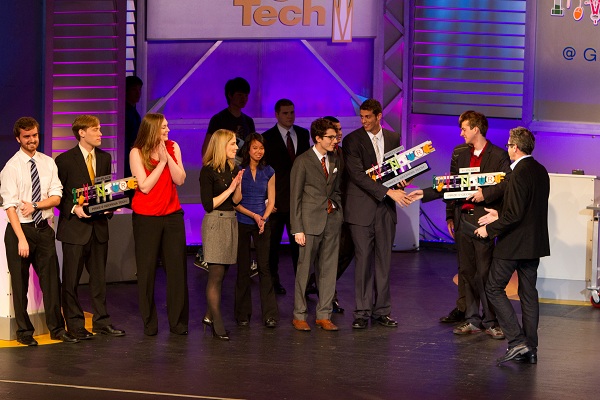
Created and organized by Tech faculty, the InVenture Prize is a yearly campus competition intended to foster student innovation and entrepreneurship. This year’s finals took place at the Ferst Center, where all seven teams had the opportunity to pitch their inventions to the audience and judges.
“The purpose of InVenture is to help students who have creative ideas and innovations,” said Ray Vito, vice provost for Graduate and Undergraduate Studies and principal organizer of the event. “The idea is to help make progress from concept to creation and, in the process, provide significant incentives and prizes.”
Televised live by Georgia Public Broadcasting, the finals were co-hosted by Miles O’Brien, NASA expert and former CNN anchor, and Dr. Bahareh Azzizi, a Tech graduate and student mentor. The panel of expert judges included Greg Foster, founder and CEO of BrightWhistle, Dr. Deborah Kilpatrick, vice-president of the genomics firm CardioDx, David Phelps, president and CEO of CreoSalus and Sara Blakely, founder of Spanx. The finalists were also judged by members of the live audience, who were encouraged to text in their votes for the $5000 People’s Choice Award.
First place went to the Slide Capo, which won $15,000 in cash and a free US patent filing worth approximately $20,000. Invented by Daniel Chaney, a fourth-year ID major, the Slide Capo is an innovative musical device that combines the idea of a guitar slide and a guitar capo.
“It’s just so easy to incorporate this device into your music and to use it to come up with techniques and sounds that you can’t do with traditional tools,” Chaney said. “The Slide Capo gives guitarists a new level of flexibility, and that gives them the ability to play faster and smoother. They take those abilities and run with them however they want.”
The Slide Capo began as a simple merging of two existing musical accessories for the guitar, but it wasn’t until after its creation that Chaney realized exactly how many options his device provided.
“It’s poised to redefine what you can do with a guitar,” Chaney said. “That’s the Slide Capo: more flexibility than you’ve ever had to be more creative than you’ve ever been.”
Second place went to the Magnetic Assisted Intubation Device (MAID), which won a cash prize of $10,000 and a free patent filing. The MAID was designed by Alexander Cooper, Shawna Hagen, William Thompson and Elizabeth Flanagan, all BMED majors. Using magnets, their invention offers a safer, more reliable way of placing breathing tubes into patients’ tracheas.
“When we started testing it, we were immediately shocked to see how well it worked,” Cooper said. “We were used to seeing intubation procedures with tubes flying everywhere and metal in people’s mouths. We just slid this through with the magnet in place, and it worked.”
Current physicians acknowledge that magnetically assisted intubation could fundamentally change a medical procedure that hasn’t changed in over 40 years.
“When I first saw the device that the students had developed, I was blown away,” said Dr. Bryan Morse, general surgeon at Grady General Hospital. “It’s probably going to change the way we look at intubation in the next five to 10 years.”
The $5000 People’s Choice Award went to the AutoRhexis, an instrument intended to improve cataract surgery. It was designed by a team of both BMED and ME majors: Christopher Giardina, Rebeca Bowden, Jorge Baro, Kanitha Kim, Khaled Kashlan and Shane Saunders.
This year’s InVenture competition began in Jan., when more than a hundred teams registered to compete for the prize. After a three-month period of preliminary rounds and presentations, seven teams qualified for the finals. Other finalists included the Proximer, a device that detects plastics in the body; AdsCreated, a computer program that generates online advertisements; Waste to Watts, an apparatus that captures and stores waste energy and the Velociryder, a two-wheeled, self-balancing skateboard.
Both winners and finalists discussed their plans for the future.
“We’ve contacted ophthalmologists across the country who are really excited about using this device,” said AutoRhexis-designer Giardina. “We’re talking about a $500 million annual market. We’re at a point in our project where we have the prototype, and all we need is the money to give it to the ophthalmologists. We can make this a reality.”
“We’ve spoken to people at one of the largest biomedical companies about getting this to market. We’ve already talked to investors about how to start raising capital to make this real,” said MAID-designer Cooper. “So we’ve got our map. We’ve got our foundation. We’re ready to start saving lives.”
Previous winners have gone on to form their own startups or license their patents. Last year’s winnner, Patrick Whaley, formed his own startup company, Titin Tech, which sells athletic training clothes that can be used to enhance workouts or assist those in the process of recovering from injuries or in physical therapy. The product, called Omega Wear, was launched last month, and orders are scheduled for delivery to customers in May.
